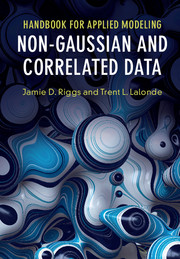Book contents
- Frontmatter
- Dedication
- Contents
- Preface
- 1 The Data Sets
- 2 The Model-Building Process
- 3 Constant Variance Response Models
- 4 Nonconstant Variance Response Models
- 5 Discrete, Categorical Response Models
- 6 Count Response Models
- 7 Time-to-Event Response Models
- 8 Longitudinal Response Models
- 9 Structural Equation Modeling
- 10 Matching Data to Models
- Bibliography
- Index
1 - The Data Sets
Published online by Cambridge University Press: 03 August 2017
- Frontmatter
- Dedication
- Contents
- Preface
- 1 The Data Sets
- 2 The Model-Building Process
- 3 Constant Variance Response Models
- 4 Nonconstant Variance Response Models
- 5 Discrete, Categorical Response Models
- 6 Count Response Models
- 7 Time-to-Event Response Models
- 8 Longitudinal Response Models
- 9 Structural Equation Modeling
- 10 Matching Data to Models
- Bibliography
- Index
Summary
Introduction
This handbook is designed to provide an accessible introduction to statistical modeling techniques appropriate for data that are non-Gaussian (not normally distributed), do not have observations independent of each other, or may not be linearly related to selected predictors. The discussion relies heavily on data examples and includes thorough explorations of data sets, model construction and evaluation, detailed interpretations of model results, and model-based predictions. We intend to provide readers with a sufficiently thorough and understandable analysis process such that the techniques covered in this text can be readily applied to any similar data situation. However, it is important to understand that we use specific data sets with the various models strictly for demonstrative purposes. The outcomes we present are not to be assumed as definitive representations of information contained within the data sets.
Throughout the text, we will use four data sets (each described in this chapter) to exhibit the analytical methods including exploration of the data, building appropriate models (Chapter 2), evaluating the appropriateness of the models, output interpretation, and predictions made by the models. The purpose of using the same data sets throughout is to show that multiple methods can be applied to similar or identical variables of interest, possibly resulting in different conclusions. Consistent use of the same data sets should maintain data familiarity. After reading this first chapter, the intention of every data analysis throughout the remainder of the text should be understood. The modeling methods that are applied to the data sets are models for responses with constant variance (Chapter 3), responses with nonconstant variance (Chapter 4), discrete categorical responses (Chapter 5), models for count responses (Chapter 6), responses that are time-dependent (time-to-event data in Chapter 7, and outcomes collected over time in Chapter 8), and models for which variables that cannot be measured directly but are represented by variables that are measurable (Chapter 9). The last chapter, Chapter 10, is a guide to matching data sets to model types.
Information
- Type
- Chapter
- Information
- Publisher: Cambridge University PressPrint publication year: 2017
